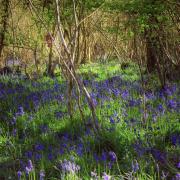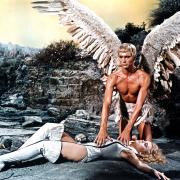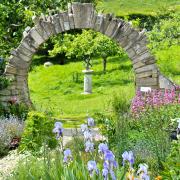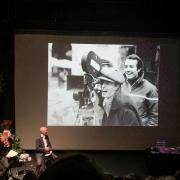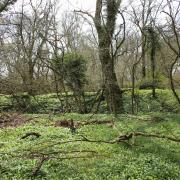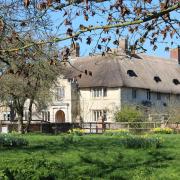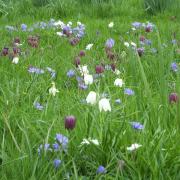Tim Laycock, Artistic Director of The New Hardy Players takes us on a literary ramble through the landscapes that inspired Thomas Hardy

“There are some heights in Wessex, shaped as if by a kindly hand
For thinking, dreaming, dying on, and at crises when I stand,
Say, on Ingpen beacon eastward, or Wylls-Neck westerly,
I seem where I was before my birth, and after death may be. “

So begins Thomas Hardy’s majestic poem, celebrating the solace that he gained from walking on the Dorset hills. Hardy was a great walker and cyclist, and the richly varied landscapes of the county were an endless source of inspiration to him. He loved the local crafts, the folk-life of the working people, the oral culture of the area and the old stories of the village communities.
In later life Hardy greatly enjoyed motoring all over Dorset with his friend Hermann Lea, showing him the houses, farms, churches and lanes that suggested places featured in the Wessex novels. Hardy was, however, always careful to say that they could never definitively be identified!

Even if we can’t get out, we can still enjoy unrivalled descriptions of the varied and beautiful landscapes of the county through Hardy’s novels and poems, and the through the eyes and the actions of his characters. So, dig out that old copy of Far From the Madding Crowd or Tess of the D’Urbervilles. If you prefer shorter stories, I recommend Wessex Scenes and Life’s Little Ironies. Both collections contain superb stories of the curious, comic and tragic goings-on of Wessex folk.
From my own front door, here’s a literary ramble around Dorset visiting in a virtual way just a few of the lovely locations to be found in Hardy’s writing. There are many more to choose from!

Stand on Hardy’s Monument - erected in 1844 to the other Thomas Hardy – Vice Admiral Sir Thomas Hardy (1769 – 1839) - and look towards the sea. Stretching out below you is the countryside of Hardy’s Napoleonic novel, The Trumpet Major. At the southern end of the Isle of Portland is the Bill, where the old sailor James Cornick and Anne Garland watch HMS Victory sail off towards Trafalgar. Down below, just to the West, is Portesham, home to Captain Thomas Masterman Hardy, Nelson’s captain in the famous sea battle. It’s hard to believe, looking at the quiet countryside below, that in 1804 the country was on a war footing, daily expecting a French invasion.
The South Dorset Ridgeway above Weymouth provides a panoramic view of the bay; this is the setting of one of Hardy’s most tragic short stories - The Melancholy Hussar of the German Legion in Wessex Tales. It’s based on a true incident. Matthaus Tina’s regiment are encamped on Bincombe Down, guarding King George. The homesick soldier deserts and attempts to cross the channel in a small boat. Bincombe churchyard, nestling beneath the hill, and surely one of the most peaceful spots in Dorset, is the final resting place of Matthaus, and the end of the story.
Along the coast to the east at Lulwind (Lulworth) Cove, the iconic landmark is the setting for another Wessex Tale, A Tradition of Eighteen Hundred and Four. An old man, formerly a shepherd boy, remembers watching curiously as a boat comes ashore at night. Napoleon and his staff disembark and consult their maps, planning their landing point. When the lantern is lit, the boy recognises with horror the distinctive features of the terrifying Emperor of France:

‘There was his bullet head, his short neck, his round yaller cheeks and chin, his gloomy face, and his great glowing eyes!’
Heading inland to north Dorset, Bulbarrow is the perfect starting point for an exploration of ‘The Vale of Blackmore’, birthplace of Hardy’s greatest literary creation, Tess Durbeyfield. The life and times of Hardy’s beautiful heroine is a series of journeys: you can follow Tess from Marlott (Marnhull) east to the Cranborne Chase, and then south to Bere Regis, and the lush valley of the River Frome where she falls in love with Angel Clare. Tess’s tragic story ends on the far outskirts of Wessex, arrested at sunrise at Stonehenge.
As one-story ends, so another begins. Not far away at Weyhill Fair (Weydon Priors), trudging west in search of work, the young Michael Henchard gets drunk on rum-laced furmitty, and sells his wife Susan for five guineas at the beginning of The Mayor of Casterbridge.
Journeying on with Henchard and his basket of tools towards Casterbridge, we come to Thomas Hardy’s birthplace – a humble thatched cottage at Higher Bockhampton. The tiny parlour, where the family passed the long winter evenings with music making, storytelling and song, is the cradle of his creativity. Upstairs is the tiny bedroom where Thomas Hardy wrote Under the Greenwood Tree and Far From the Madding Crowd. The cottage is surrounded by the countryside that inspired both novels. Take the path from the car park through Thorncombe Woods to the cottage, and you will be in the company of Michael Mail, Dick Dewey, Elias Spinks, and all the other Mellstock musicians and singers, making their way on Christmas Eve to practice their carols before setting out once more ‘Going the Rounds’.
Climb up to the top of the heath behind the cottage, and you will find Rainbarrow, one of many ancient earthworks covering the South Dorset Ridgeway. Here you will be standing on the very spot where Jems Purchess and John Whiting in The Dynasts stand nervously guarding the beacon, ready to light it the moment news of the inspected French invasion is confirmed. It’s also the spot where the heath folk of Egdon light their midwinter bonfire at the beginning of The Return of the Native, when they are startled by the apparition of one of Hardy’s greatest characters, Diggory Venn the Reddleman.
So many stories, and so many beautiful places. No other county can boast great literature so perfectly placed in its landscape; Truly, Thomas Hardy did Dorset proud!
______________
Tim is the Artistic Director of the New Hardy Players (hardyonline.org). His most recent CD (with violinist Colin Thompson) is Any Little Old Song Will Do, a collection of songs, dance tunes and poetry from Hardy’s Cottage.
Tim has recently published a new book Dorset Folk Tales for Children.
Find more at timlaycock.co.uk




